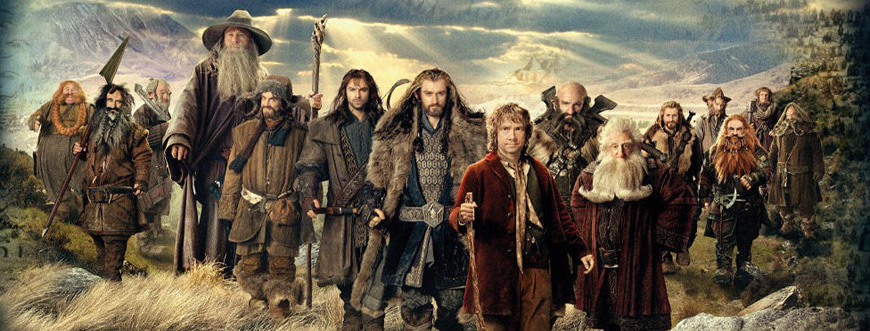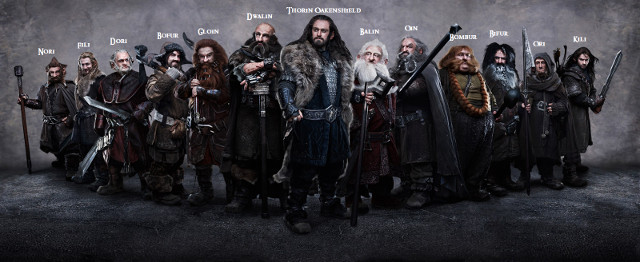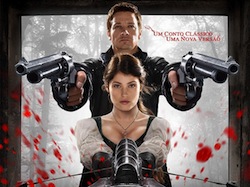
You know you’re a Tolkien geek when you spend a half hour with fellow critics arguing the relative merits and absolute worthiness of The Hobbit vsThe Lord of the Rings series by Peter Jackson. Cinema Siren’s position is: One needn’t choose sides, as if there is a finite amount of room for Middle Earth in the pop culture zeitgeist.
I for one can never get enough of the fierce wizard, fiery dragon, elven queen, and that furry footed fellow Bilbo. Honestly, I just don’t understand anyone saying “it isn’t The Lord of the Rings.” After two Hobbit movies, have they not settled into this story and these characters enough to watch them navigating through their own tale, which is markedly different than LOTR?
And inhabit the story they do, with all their soul and passion. As the name suggests, a large portion of this last Hobbit film is the battle, but how Bilbo, and the many adventurers of this series take part, how they show their heroism and weaknesses, is what gives the last installment of Peter Jackson’s epic interpretation of J.R.R. Tolkien’s classic its heart.
The Battle of the Five Armies, or TBOTFA to the fandom, is the culmination of a story famously and rather dubiously spread over three films, taking up nine fantasy and CGI-filled hours. Somehow, miraculously, Jackson makes it work. TBOTFA is definitely the most engaging of the three films, and brings the entire series together in a way that will be appreciated more as time passes.
An Unexpected Journey started out a bit bumpy and slow, as Jackson was front-loading the trilogy with much exposition and character development. Try as he might, however, it was difficult for audiences to warm to the various dwarf adventurers attempting to regain their home, and with few exceptions, the first film only really soared in scenes between Bilbo and Gollum.
The second, The Desolation of Smaug, allowed audiences to embrace not only the individual dwarves, their leader Thorin Oakenshield (Richard Armitage) and Hobbit burglar Bilbo Baggins (Martin Freeman), but other new characters like Bard the Bowman (Luke Evans) and elves Tauriel (Evangeline Lilly) and Thranduil (Lee Pace) whose personalities were given more time and action to connect them to the viewers.
Even as the second film ended with the plot infuriatingly unresolved, it was far more integrated and engrossing overall. The final installment is without question the best of the three, allowing the stories of our human, Hobbit, Elven, and dwarfish heroes to stretch through their full arcs to great satisfaction and closure however glorious, tragic, poignant, selfless, or spectacular they may be.
In particular, Martin Freeman’s Bilbo comes into his own in a way that completely wins audiences, especially as one remembers how grumpy and noncommittal he was at the story’s beginning. Regardless of the goings on of other storylines,TBOTFA is always grounded in his perspective, his experience. When he becomes resolutely committed to his company of dwarves, he takes the audience to that place of brotherhood with him.
The casting has always seemed perfect, but we see how adeptly Freeman finds authentic resolve in the mannerisms and quirks we’ve come to expect as he has inhabited his character. Luke Evans’ Bard gets far more screen time and a far more important leadership role in TBOTFA, and the actor shows he can bring believability to the odd mix of swagger and humility so beguiling in the human hero. Ian McKellen’s Gandalf is as wise and formidable as ever.
Lee Pace, an actor who has a strong cult following, finally gets to turn on the full power of Elvenking Thranduil’s majestic magnetism while nuancing the character’s inner struggles as a father and leader of his clan.
Richard Armitage as Thorin Oakenshield has the hardest emotional transitions to maneuver. In some respects, the success or failure of believability in the decisive moments and the climax of TBOTFA, therefore of the whole trilogy, hangs with him. He shows not just how well suited to the role he is, but commits to the full emotional spectrum of Thorin’s personal journey as only a great actor can. He will likely get no recognition for his work, since portrayals in scifi and fantasy rarely get the attention in acting awards circuits.
Look for a wonderful cameo by Billy Connelly as a blustering battle-ready dwarf, and a predictably spectacular acting turn by Cate Blanchett as Galadriel in a flamboyant CGI-heavy scene that would have been ridiculous in lesser talented hands.
The least successful of threads is that including Evangeline Lilly as Tauriel and Orlando Bloom as Legolas, which involves a love triangle that at times seems somewhat underdeveloped, as do both characters’ motivations therein. That could be explained by pointing to the relative laconic and even-keeled nature of elves in general. There are certainly moments of poignancy, but it may this part of the film that has critics and some fans comparing it less favorably to The Lord of the Rings, where the romance between Aragorn and Arwen was one of the lynchpins of the story.
This being, as the hashtag says, “one last time,” it is time to revel in the beauty of the New Zealand landscapes Jackson and his team used for this series, as he did in LOTR, and enjoy the balance of gorgeous natural vistas integrated with the latest advances in CGI courtesy of the computer wiz kids at WETA digital in New Zealand.
Advancements overshadow and outdate films released as little as six months before. The real yet other-worldly landscapes of New Zealand, blended with the use of WETA’s special effects, seem to set not only the older LOTR series but also this new trilogy apart from that obsolescence, and may do so indefinitely. Only time will tell, but it speaks to the place these Tolkien interpretations of Jackson will surely find in the history of film.
See it, fans of epic fantasy, to celebrate Middle Earth and Jackson’s achievement one last time.
4 out of 5 stars.







